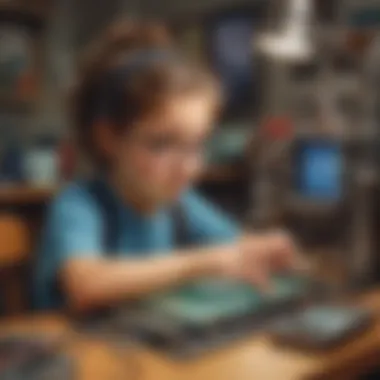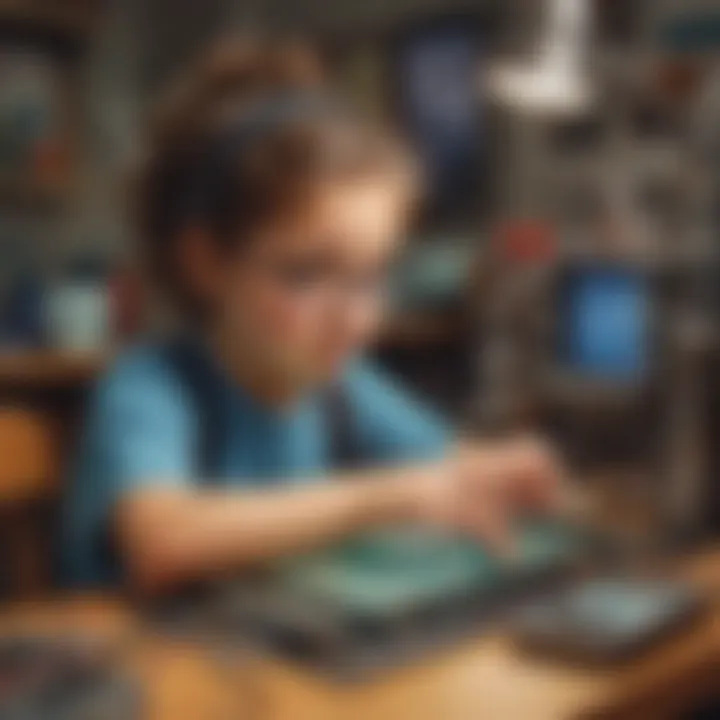Exploring the Interdisciplinary Nature of STEAM Education


Intro
The interdisciplinary nature of STEAM education encompasses more than just the subject of science, technology, engineering, arts, and mathematics. Each component connects in significant ways that enhance learning and creativity in young learners. This article outlines these connections and illuminates how integrating these fields creates a robust educational framework. Engaging children in these subjects not only nurtures critical thinking but also prepares them for future careers that require a blend of these skills. By examining the intersections of STEAM, we address the need for a holistic educational approach.
Science Fun Facts
Interesting Trivia and Facts
Did you know that water can boil and freeze at the same time? This phenomena is called the "triple point". It is an interesting aspect of thermodynamics that can capture the curiosity of young minds. Science is full of such surprises that encourage exploration.
Quirky Science Stories
One fascinating story is about the discovery of penicillin by Alexander Fleming. He accidentally left a petri dish uncovered, and mold contaminated it. Instead of discarding it, he observed that the mold prevented bacterial growth. This chance discovery revolutionized medicine and highlights the value of observation.
Amazing Science Records
The largest living organism is a fungus located in Oregon called Armillaria ostoyae. It covers an area of approximately 2,385 acres. This fact showcases nature's wonders and prompts young learners to think about ecosystems.
Thought-Provoking Questions
- What would happen if humans could fly?
- How does the design of a bridge affect its strength?
- Why do artists use different materials to express their thoughts?
These questions can initiate interesting discussions and further investigations, pushing the boundaries of young learners' creativity.
Discover the Wonders of Science
Exploring Various Scientific Concepts
Understanding the basics of physics, biology, and chemistry can help children appreciate how the world works. For instance, learning about the lifecycle of plants or the properties of forces encourages hands-on exploration and critical thinking.
Educational Videos and Animations
Visual aids are crucial in communicating scientific concepts. Platforms like YouTube offer countless videos that dive into complex topics in an engaging way. These resources can effectively spark interest in science.
Interactive Learning Tools
Websites like Khan Academy or PBS Learning Media provide interactive tools that make learning more engaging. Students can experiment and learn at their own pace, which supports different learning styles.
Real-Life Applications of Science
Connecting science to real-world applications can boost children's interest. For example, discussing environmental conservation can lead to projects on recycling. This demonstrates how scientific principles manifest in daily life.
Science Quiz Time
Interactive Quizzes
Engaging quiz platforms can reinforce learning. Websites like Kahoot! allow for interactive quizzes that make testing knowledge enjoyable.
Multiple Choice Questions
- What is the chemical formula for water?
a) CO2
b) O
c) O2 - Which planet is known as the Red Planet?
a) Mars
b) Jupiter
c) Venus
Brain Teasers and Puzzles
Simple puzzles can challenge young minds while making them think scientifically. For example: "If you have three apples and take away two, how many do you have?"
Learning Through Gamification
Gamification turns educational content into games, which can increase engagement. Websites that offer science games can be beneficial in merging learning with fun.
Science Experiment Showcase
Fun and Engaging Experiments
Experiments like creating a volcano using baking soda and vinegar can make science enjoyable. These experiments also teach children about reactions.
Step-by-Step Instructions
- Gather materials: vinegar, baking soda, food coloring, and a container.
- Place the container on a tray to catch overflow.
- Add food coloring to vinegar and pour into the container.
- Slowly add baking soda and watch the reaction!
Materials List
- Baking soda
- Vinegar
- Food coloring
- Container
- Tray
Safety Tips and Precautions
Always conduct experiments under adult supervision. Avoid swallowing any materials used.
Engagement through inquiry and hands-on activities enhances the learning experience for children as they discover the world around them.
By fostering curiosity and creativity across the STEAM subjects, educators and caregivers can play a crucial role in inspiring the next generation of innovators.
Prelims to STEAM Education
STEAM education plays a vital role in modern learning environments. This approach combines Science, Technology, Engineering, Arts, and Mathematics to create a well-rounded educational experience. Recognizing this interdisciplinary nature is important for developing students' critical thinking and problem-solving skills. In today's world, where innovation and creativity are key to success, understanding STEAM becomes crucial. The synergy among these disciplines encourages learners to think beyond traditional boundaries.
Defining STEAM
To fully appreciate the significance of STEAM, it is essential to define it clearly. STEAM refers to an educational framework that integrates five distinct but interconnected disciplines. Each component contributes unique insights and methods.
- Science provides a foundational understanding of natural phenomena through observation and experimentation.
- Technology focuses on the tools and techniques that enhance learning and practical applications.
- Engineering teaches design principles and emphasizes problem-solving through real-world challenges.
- Arts foster creativity and encourage expression, enriching the learning process.
- Mathematics offers a logical framework for analyzing problems and making sense of data.
By combining these areas, STEAM education prepares students for an increasingly complex world.
Historical Context
The roots of STEAM education can be traced back to initiatives aimed at improving STEM education. In the 21st century, educators recognized the need to integrate the arts into this framework. This shift responded to a growing understanding that creativity is essential for scientific and technological advancements.
Historically, educational systems were more siloed, separating subjects into distinct areas. However, as society has evolved, so too has our understanding of knowledge interrelations. The educational landscape is now better suited for interdisciplinary learning, reflecting the needs of modern careers.
"The integration of arts into STEM ensures that education is not only about facts but also about imagination and cultural perspective."


Overall, the historical evolution of education demonstrates an increasing recognition of how disciplines influence one another. This progress in educational philosophy underscores the importance of STEAM in contemporary learning.
The Role of Science in STEAM
Science is a foundational element of STEAM education, providing the framework upon which students can explore the natural world. It encourages curiosity and a desire to understand phenomena that occur throughout our environment. In this section, we will discuss the importance of science in STEAM, including its fundamental concepts and the methodology employed in scientific inquiry.
Fundamental Concepts
At its core, science is based on observation, experimentation, and evidence. The ability to ask questions and seek answers is a critical aspect of learning through science. Topics like biology, chemistry, physics, and earth science allow students to delve into various processes and laws governing our world.
Some fundamental concepts in science are:
- Matter and its properties: Understanding what everything is made of.
- Energy and its forms: Learning about different types of energy and how they can change forms.
- The scientific method: A systematic approach to inquiry.
By grasping these ideas, students not only learn about the world but also cultivate critical thinking skills. They begin to understand that science is not just a subject; it's a way of thinking and approaching problems.
Scientific Methodology
Scientific methodology is a structured method for investigation. This process begins with observation and questioning. From there, students formulate hypotheses, conduct experiments, gather data, and draw conclusions. This method enhances problem-solving skills and encourages thorough examination of concepts.
The steps of the scientific method typically include:
- Observation: Noticing something interesting.
- Question: Formulating a question based on the observation.
- Hypothesis: Making an educated guess or prediction.
- Experimentation: Testing the hypothesis through experiments.
- Analysis: Evaluating the results and finding patterns.
- Conclusion: Drawing conclusions from the evidence gathered.
"Science is about questioning the world around us and finding answers through observation and experiments."
This methodology is crucial for students, as it builds a foundation for understanding not only scientific principles but also how to tackle real-world challenges. In next sections, we will analyze the role of technology as a backbone and resource for modern learning.
Technology: The Backbone of Modern Learning
Technology plays an indispensable role in today’s educational landscape. Its integration into classrooms enhances learning experiences by providing access to diverse resources and innovative methods of engagement. Understanding technology’s significance allows educators and parents to better prepare children for a future that increasingly relies on digital skills.
The capabilities of technology extend beyond mere access to information. It facilitates collaborative learning, encourages critical thinking, and promotes creativity among students. The avenues through which learners engage with content have expanded. Whether through educational software, online research, or interactive simulations, technology cultivates an environment conducive to discovering and validating ideas collaboratively.
Digital Literacy
Digital literacy has emerged as a fundamental component in the modern educational curriculum. This concept encompasses not only the ability to use technology but also understanding, evaluating, and communicating information through digital means.
For young learners, it is crucial to develop digital literacy skills early on. Children should learn how to navigate various platforms, discern credible sources, and safely interact online. School programs emphasize these skills by incorporating lessons on online etiquette, privacy, and critical evaluation of information. Additionally, engaging with technology from a young age fuels confidence in using tools for learning and inquiry.
Guided exploration of digital literacy can lead to profound implications. Not only does it prepare students for future academic pursuits, but it also assists them in becoming informed citizens in a digital age.
Tools and Platforms for Education
The range of tools and platforms available for education is vast and continually evolving. These resources are designed to cater to various learning styles while supporting curriculum standards.
- Learning Management Systems (LMS): Platforms like Google Classroom and Moodle enable teachers to organize resources, assignments, and communication in one digital space. These systems help streamline classroom management and foster engagement among students.
- Interactive Software: Programs such as Kahoot and Quizlet make learning more dynamic and interactive. By integrating games into lessons, students can enjoy their learning journey while absorbing key concepts.
- Creative Tools: Software like Tinkercad and Scratch allows children to engage in creative problem-solving. By creating models or coding simple animations, children not only learn technical skills but also nurture their creativity.
- Online Resources: Websites like Khan Academy and Coursera provide access to free learning materials across various subjects. These resources promote self-directed learning, allowing students to delve deeper into topics of interest at their own pace.
- Collaboration Tools: Programs such as Padlet and Trello facilitate teamwork. Children can work together on projects, share ideas, and receive feedback in real time. This collaboration is vital as it mimics real-world work environments where teamwork is essential.
Incorporating these tools into the classroom can greatly enhance the educational experience. This not only enriches learning but allows educators to tailor their teaching strategies effectively, focusing on each child’s unique needs.
Embracing technology in education is no longer optional; it is essential for preparing students for their future endeavors.
By understanding and optimizing the impact of technology in education, we lay the groundwork for a well-rounded STEAM curriculum that not only includes Science, Technology, Engineering, Arts, and Mathematics but also cultivates an inquisitive and collaborative mindset in young learners.
Engineering: Bridging Theory and Practice
Engineering plays a vital role in the STEAM framework. It serves as a conduit linking theoretical concepts with practical applications. Educators emphasize the importance of engineering because it encourages students to solve real-world problems. This discipline instills in young learners the ability to think critically and approach challenges with creativity and analytical skills. Integrating engineering into the educational curriculum supports a comprehensive understanding of how various concepts interconnect across the STEAM fields.
Principles of Engineering Design
One foundational aspect of engineering is the design process. This process often includes several stages: defining the problem, researching, brainstorming, creating prototypes, testing, and evaluating outcomes. Students learn that effective design requires not only technical skills but also creativity and collaboration.
- Defining the Problem: Clearly outlining what needs to be solved helps to guide the entire project.
- Research: Gathering information related to the problem helps students understand possible solutions and existing technologies.
- Brainstorming: Students generate various ideas, fostering creative thinking.
- Creating Prototypes: Building a model or version of the solution draws on both technical knowledge and imaginative skills.
- Testing and Evaluating: This critical stage assesses if the solution meets the requirements and identifies areas for improvement.
Engineering emphasizes learning through experience. By following these principles, students understand the iterative nature of design. They grasp that mistakes are not failures but opportunities for growth and discovery.
Real-world Applications
The real-world implications of engineering are vast and diverse. From designing bridges to developing software, engineering shapes the environments in which we live. By incorporating real-world applications into classroom activities, educators can demonstrate the relevance of engineering principles.
For instance:
- Urban Planning: Understanding how engineers design sustainable cities encourages critical thinking about community issues.
- Environmental Engineering: Problems like water pollution and waste management highlight the importance of engineering solutions for sustainability.
- Robotics: Engaging with robotics fosters interest in technology and programming, illustrating engineering's role in innovation.
"Engineering transforms theoretical concepts into tangible solutions that impact society daily."
Through these practical applications, students can relate their learning to the world around them. They discover how engineering disciplines are integrated into everyday life.


The Arts: Fostering Creativity in STEAM
The arts play a critical role in enriching STEAM education. They contribute significantly to developing creativity, critical thinking, and problem-solving skills. In today’s world, where innovation is key, integrating the arts into scientific and technical subjects cultivates a more comprehensive understanding of complex concepts. This interdisciplinary approach encourages learners to explore beyond traditional methodologies.
Art allows students to visualize abstract ideas. For example, students can grasp scientific phenomena better when they create a visual representation of their understanding. Similarly, using art enables them to communicate their ideas effectively. This exchange across disciplines nurtures innovative minds, leading to inventive solutions in both artistic and scientific fields.
By infusing arts into disciplines like science, technology, engineering, and mathematics, educators can create more engaging curriculums. Students become active participants in their learning process, connecting theories to tangible outcomes. As they engage in creative projects, they not only develop their artistic skills but also experience the logical reasoning behind scientific inquiry. Through this blend, they learn how the aesthetics of art can impact scientific communication and understanding.
Integrating Arts into STEM
To successfully integrate arts into STEM education, several strategies can be implemented. This integration can manifest through collaborative projects that require both artistic and scientific thinking.
- Cross-Disciplinary Projects: Students can engage in projects that combine engineering concepts with design elements. For example, students might design a bridge while also exploring the mathematics behind forces and tensions.
- Arts-Based Learning Activities: Incorporating drawing, music, or performance can enhance engagement. For instance, a class might study the impact of sound waves through music composition.
- Technology as a Tool for Creativity: Using software for digital art or programming to create animations can introduce students to both artistic flair and technical skills.
This approach not only caters to diverse learning styles but also promotes collaboration among students. They learn to respect each other’s input, fostering team spirit and empathy. As they navigate different perspectives, their creativity flourishes in problem-solving situations.
The Importance of Creativity
Creativity isn't just about producing art; it’s a powerful tool for innovation. In STEAM education, creativity drives exploration and motivation. It pushes students to think outside the box and approach problems from various angles. Discovering new solutions often requires imagining alternatives and visualizing potential outcomes.
In STEAM, creativity relates to:
- Adaptability: The ability to modify solutions based on feedback.
- Critical Thinking: Analyzing problems from interdisciplinary views, leading to unique solutions.
- Resilience: Learning to iterate and redesign based on failures fosters a growth mindset essential in all disciplines.
"Creativity is thinking up new things. Innovation is doing new things." – Theodore Levitt
By fostering creativity, educators prepare children for a future where they face complex challenges. As a result, integrating arts into STEAM helps develop adaptable thinkers who can navigate and contribute across various fields.
Mathematics: The Common Language of STEAM
Mathematics serves as a foundational cornerstone within the STEAM framework. It acts not only as a tool for quantitative analysis but also as a unifying language that connects the diverse disciplines of Science, Technology, Engineering, and Arts. Understanding mathematics is crucial for educators and students. It helps to cultivate a mindset focused on problem-solving and critical thinking, which are essential in today’s world.
Furthermore, mathematical concepts provide the necessary skills for understanding algorithms in technology and are vital in engineering design processes. Thus, an integrated approach that emphasizes the importance of mathematics within the STEAM curriculum can enhance students' ability to apply it across various contexts.
Mathematical Foundations
The fundamental elements of mathematics form the basis for various STEAM applications. These include arithmetic, geometry, algebra, and statistics. Each of these areas contributes significantly:
- Arithmetic: Basic operations such as addition, subtraction, multiplication, and division are essential for daily calculations and practical problem-solving.
- Geometry: Understanding shapes, sizes, and the properties of space boosts knowledge in fields like architecture and art.
- Algebra: This branch develops the ability to formulate and solve equations, nurturing logical thinking and reasoning skills.
- Statistics: Collecting and analyzing data is crucial in science and social studies. This area equips students to make informed decisions based on data analysis.
Mathematical foundations foster a structured way of thinking, which aids in logical reasoning across all STEAM subjects. Additionally, these concepts encourage creativity, which is pivotal when engaging in interdisciplinary projects.
Mathematics in Problem Solving
Mathematics plays a vital role in problem-solving. It provides techniques and methods that are applicable in real-world situations.
When faced with a challenge, consider:
- Identifying the Problem: Understanding what needs to be solved is the first step. Questions such as "What information do I need?" and "What tools will help?" guide the thought process.
- Formulating a Plan: Mathematically, this can involve setting up equations or using diagrams. Creating a visual can simplify complex ideas.
- Implementing the Solution: Applying the chosen methods and conducting calculations promotes active engagement. It also enables learners to make adjustments as needed.
- Evaluating the Results: Reflecting on whether the solution adequately addresses the original problem is crucial. This step reinforces the importance of accuracy and thoroughness in mathematical thinking.
By integrating mathematics into various problems, learners become equipped to face complex challenges across different STEAM fields.
The ability to use math effectively in problem-solving not only nurtures creativity but also enables students to approach challenges with confidence, preparing them for future endeavors.
Mathematics is not just numbers; it's a way to understand the world.
Benefits of an Integrated STEAM Curriculum
An integrated STEAM curriculum offers numerous advantages to students. This approach combines the five disciplines: Science, Technology, Engineering, Arts, and Mathematics into a cohesive learning experience. Essential to this integrated learning are two critical elements: the development of personal skills and enhanced academic performance. In today's rapidly changing world, these benefits are vital for preparing students for future challenges.
Critical Thinking Skills
Critical thinking skills are a core outcome of an integrated STEAM curriculum. Students learn to analyze problems from multiple perspectives. This method encourages them to ask questions and seek effective solutions. Science teaches students to interpret data. Mathematics, on the other hand, introduces logical reasoning and analytical skills. When paired with the creativity fostered by the Arts and the practical applications from Engineering, students can tackle complex problems with confidence and clarity.
Studies suggest that learners who engage in STEAM activities show improved critical thinking abilities. The interdisciplinary approach forces them to think outside their usual paradigms, stimulating deeper understanding.
Collaboration and Teamwork
Another important benefit is the emphasis on collaboration and teamwork. STEAM projects often require students to work together. They must communicate ideas, share responsibilities, and provide feedback. This collaborative environment mirrors real-world scenarios where teamwork is essential. Through group projects in the classroom, students learn how to value diverse viewpoints and integrate different skill sets. These experiences cultivate interpersonal skills that will prove valuable in their academic and professional futures.
- Benefits of collaboration include:
- Improved communication skills
- Enhanced social skills
- Higher potential for creativity and inspiration
Fostering Innovation
Fostering innovation is a vital benefit of an integrated STEAM curriculum. Combining these disciplines encourages creative thinking. Each subject brings its own perspective, which leads to unique combinations of ideas. For example, a project may involve creating a new app (Technology) that solves a scientific problem (Science) while considering user experience (Arts) and incorporating mathematical algorithms (Mathematics). This blend of knowledge encourages students to think creatively. As they explore various solutions, they learn that failure is often part of the innovation process. This experience is crucial for cultivating resilience, pushing the boundaries of what they can achieve.


In summary, the integrated STEAM curriculum leads to skill development that is critical for young learners. By promoting critical thinking, collaboration, and innovation, it prepares students not just academically, but also personally, ensuring they are ready to face complex challenges in their future.
Challenges in STEAM Education
Exploring challenges in STEAM education is vital. Understanding these obstacles helps educators, parents, and policymakers shape better strategies. Each aspect of STEAM can present unique difficulties that influence how effectively these disciplines integrate into the curriculum. The multifaceted nature of STEAM means that addressing these challenges is crucial for both students and teachers.
Curriculum Development
Curriculum development is one of the most significant challenges in STEAM education. An effective curriculum must blend science, technology, engineering, arts, and mathematics seamlessly. Unfortunately, many existing curriculums may emphasize one discipline over others. This imbalance can hinder students’ abilities to think critically across multiple fields. When educators seek to create a balanced curriculum, they often face obstacles such as a lack of resources, inadequate training, or insufficient support from educational institutions.
To develop a cohesive STEAM curriculum, educators can follow specific steps:
- Conduct needs assessments: Understand the unique requirements of the student population before design.
- Collaborate with other educators: Integrate insights from various specializations for a comprehensive curriculum.
- Incorporate project-based learning: Allow students to engage in real-world scenarios that encompass multiple disciplines.
- Utilize technology effectively: Implement tools that encourage interaction and exploration among different subjects.
Teacher Training and Resources
Another critical challenge is teacher training and resources. Many teachers feel unprepared to teach a STEAM-focused curriculum. This limitation is often due to a lack of training in interdisciplinary teaching methods. It is essential that teachers receive adequate professional development to facilitate effective teaching in STEAM.
Resources play an important role in this training. Teachers can enhance their skills through:
- Workshops and seminars: Engage in ongoing education that focuses on new methods and technologies in education.
- Collaborative networks: Join online forums such as Reddit or Facebook pages tailored to educators. These platforms often provide practical tips and a community of support.
- Access to materials: Schools should allocate funding for resources necessary to teach STEAM subjects effectively. This includes technology, kits for hands-on projects, and access to online databases.
"Effective STEAM education requires a commitment to continuous improvement in teaching practices and resource allocation. By facing these challenges, we can promote innovative and critical thinkers for the future."
By addressing the challenges in curriculum development and teacher training, stakeholders can enhance the overall effectiveness of STEAM education. A balanced approach leads to improved learning outcomes for students and strengthens their readiness for future careers.
Future of STEAM in Education
The landscape of education continues to evolve, presenting new opportunities and challenges. The future of STEAM education reflects this transformation. Emphasizing the integration of Science, Technology, Engineering, Arts, and Mathematics, it plays a vital role in preparing students for a complex world. The relevance of this topic goes beyond curriculums; it embodies a holistic approach to learning that encourages adaptability, creativity, and critical thought. It becomes essential as we equip young minds with skills for future endeavors.
Emerging Trends
To navigate the future effectively, it is crucial to recognize emerging trends that shape STEAM education. Some of these trends include:
- Personalized Learning: As technology advances, personalized education that caters to individual learning styles and paces becomes more accessible. This tailored approach helps engage students deeply, fostering their interests and strengthening their capabilities.
- Interdisciplinary Projects: Schools are increasingly adopting project-based learning that necessitates collaboration among various disciplines. This method helps students apply their knowledge comprehensively, enhancing their problem-solving and teamwork skills.
- Incorporation of Technology: Tools like virtual reality (VR) and augmented reality (AR) are becoming prevalent in classrooms. These technologies offer immersive experiences, making abstract concepts tangible and engaging for young learners.
- Focus on Environmental Sustainability: With the rising awareness of climate change, there's a push to incorporate sustainability into the curriculum. Projects related to ecology or renewable energy empower children to think critically about global challenges.
These emerging trends promise a more responsive and engaging educational environment, addressed to the interests and needs of today’s youth.
Policy Implications
Policy decisions influence the trajectory of STEAM education significantly. Governments and educational bodies play crucial roles in the field, impacting various aspects of teaching and learning. Some key points to consider include:
- Funding for STEAM Programs: Governments must prioritize funding for the development and implementation of STEAM programs. Financial support enables schools to purchase resources and provide training for teachers, essential for effective teaching.
- Curricular Integration: Education policies should emphasize the integration of STEAM within all levels of education. This would ensure that every student has access to interdisciplinary learning, which is vital in fostering critical thinking.
- Standards and Assessment: Establishing clear standards and effective assessment methods for STEAM subjects helps maintain educational quality. It is essential to create benchmarks that reflect both technical and creative competencies.
Practical Applications in Classroom Settings
Practical applications in classroom settings create a bridge between theoretical concepts and real-world experiences. It plays an essential role in STEAM education by allowing students to engage with content in a meaningful way. Through hands-on activities, children can better grasp complex ideas and retain knowledge more effectively. Utilizing practical methods aids in avoiding rote learning, which often fails to inspire curiosity and critical thinking.
Hands-on Learning Experiences
Hands-on learning experiences are central to STEAM education. This approach encourages students to explore and experiment actively. When learners participate in tangible projects, the principles they study in class become much clearer. For instance, building a simple circuit gives students insights into electrical engineering while relating directly to scientific theories. These projects foster an atmosphere of exploration and inquiry.
Some benefits of hands-on learning include:
- Improved Understanding: Students develop a stronger comprehension of abstract concepts.
- Engagement: Active participation keeps learners focused and engaged.
- Skill Development: Practical tasks encourage skills such as problem solving, collaboration, and persistence.
Project-Based Learning
Project-based learning enhances the efficacy of STEAM by focusing on long-term projects that combine multiple disciplines. In this learning format, students work on projects addressing real-world problems or questions. This encourages them to integrate their knowledge from science, technology, engineering, art, and mathematics, making connections that enhance understanding.
Key elements of project-based learning involve:
- Collaboration: Students often work in groups, promoting teamwork and the sharing of ideas.
- Real-World Relevance: Tasks are relevant to students' lives, encouraging them to take ownership of their education.
- Reflection: Students evaluate their approaches and the results of their projects, fostering critical thinking.
Project-based learning is vital for developing essential soft skills needed in today’s workforce.
The End
In discussing the interdisciplinary nature of STEAM education, we have delved into a framework that combines the essential elements of Science, Technology, Engineering, Arts, and Mathematics. This integration is not merely an educational trend; it represents a critical approach to fostering a well-rounded learning experience for young learners. The importance of STEAM cannot be overstated, especially in a rapidly changing world where innovation and creativity are paramount.
Summary of Key Points
- Defining STEAM: We explored how each discipline contributes to the overall goal of enhancing student engagement and understanding.
- The Role of Creativity: Integrating arts into the core scientific and technological subjects helps nurture creativity, which is crucial for problem-solving.
- Practical Applications: Hands-on learning through project-based methods enriches students' grasp of theoretical concepts.
- Future Relevance: The skills acquired through STEAM education are increasingly relevant, preparing children for diverse careers in the future.
This article has emphasized that STEAM education cultivates not just academic skills but also soft skills like teamwork and critical thinking. By employing an integrated approach, students are encouraged to think holistically and interdisciplinary.
The Importance of Continuous Learning
Continuous learning is vital in the context of STEAM education. As knowledge and technologies evolve, so too must teaching strategies and curricula. Lifelong learning ensures that both educators and students stay informed about the latest advancements in their fields. This adaptability can significantly enhance the educational experience, making learning not just a phase of life, but a constant pursuit.
"Education is not preparation for life; education is life itself."
In summary, embracing continuous learning within STEAM education is essential for both educators and students. It fosters an environment of inquiry and adaptation, encouraging learners to remain curious and engaged throughout their lives. The intersection of these disciplines is not merely a backdrop for learning; it is the foundation upon which we can build future generations equipped with the knowledge and skills necessary to navigate an ever-evolving world.







